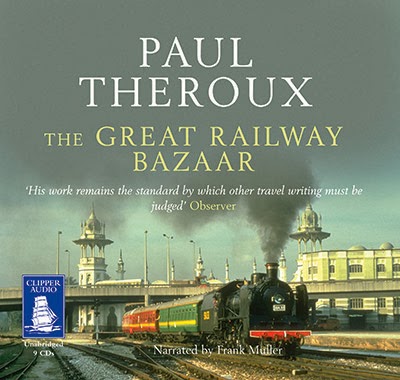 |
| That's a lotta rail ties |
Traveling from the east you pass through the endless taiga tunnel, days upon days without a change in the view. It is like a spell, both mesmerizing and claustrophobic. I can see why Paul Theroux in the Great Railway Bazaar finally lost it a bit here, lonely, and tired of traveling after 4 months on the road.
 |
| An all-time classic of travel writing, plus it's all on my favorite mode of transport! |
The Russian dining car is so quiet that I when I first stumbled upon I wasn't sure it was even open. Instead of sticky beer floors and the smell of tasty strange noodles cooking in the air, there was only empty table after table. Each was anointed with a spotless red tablecloth, artfully folded napkins, ceramic salt and sugar cups, and even a little vase with a plastic flower. To top it off, there was real silverware laid out. I couldn't remember the last time I saw a fork, knife, and spoon on tablecloth. It all looked odd and neat and sterile and, well, sadly boring. And at that moment, I couldn't help but feel a little pang of nostalgia for chopsticks and spicy noisy Asian restaurants with their bizarre "who the hell knows what I'm about to eat or what animal it could be from" plates.
 |
| The Russian Dining car: spotless, overpriced, and sadly empty. |
Not too much time later, I was sitting down to a hot meal of soup, meat, bread, pickles, and of course, espresso. The food might not have been the best, but it had been so long since I'd had western food I nearly gobbled up my fingers as I stuffed it in. And the fresh espresso, with cold liquid cream.... wow. Delicious. There were some things that I was NOT going to miss about Asia. But why were things so empty? The answer soon came with the bill. My simple meal had cost over 600 rubles. About $20 US. A fortune in Asia. On the Mongol train, dinner cost $3-4 and a can of lukewarm beer was less than a buck. No wonder the Russians stayed in their cars and didn't mingle.
I thought back on Paul Theroux's writing, how the dining car on Europe's trains were generally full of well-heeled customers traveling to exotic locales. But that time had passed: the well-heeled were flying overhead in comfortable 747's. Yet this expensive dining car remained, frozen in time, waiting for a man in a 3-piece suit and pipe to sit down with his paper. It was a theme I would see later again in again in Eastern Europe: past glories of Soviet Russia, proudly displayed, slowly decaying.
I finished my meal in silence, alone. It would be a long train ride.
No comments:
Post a Comment